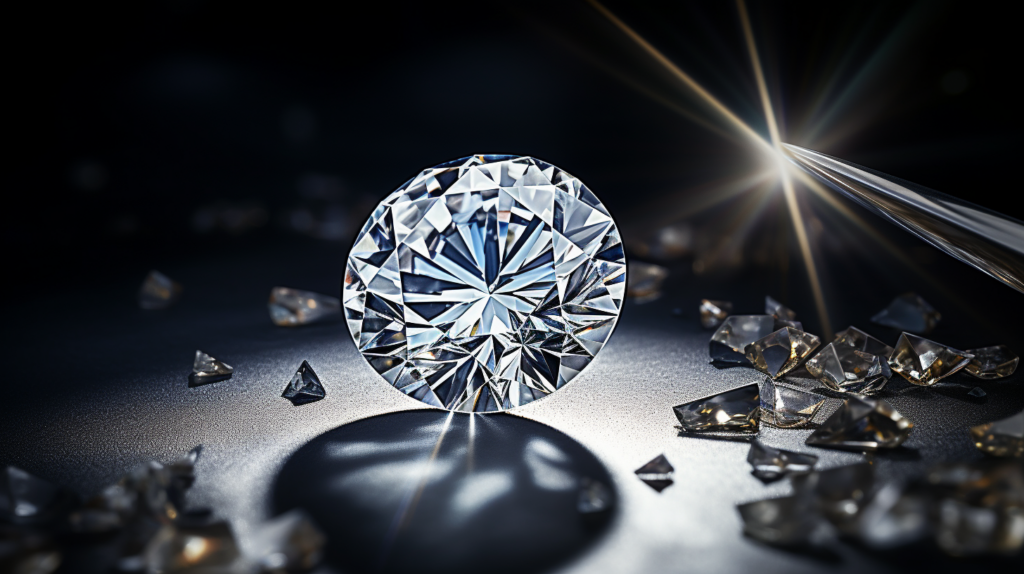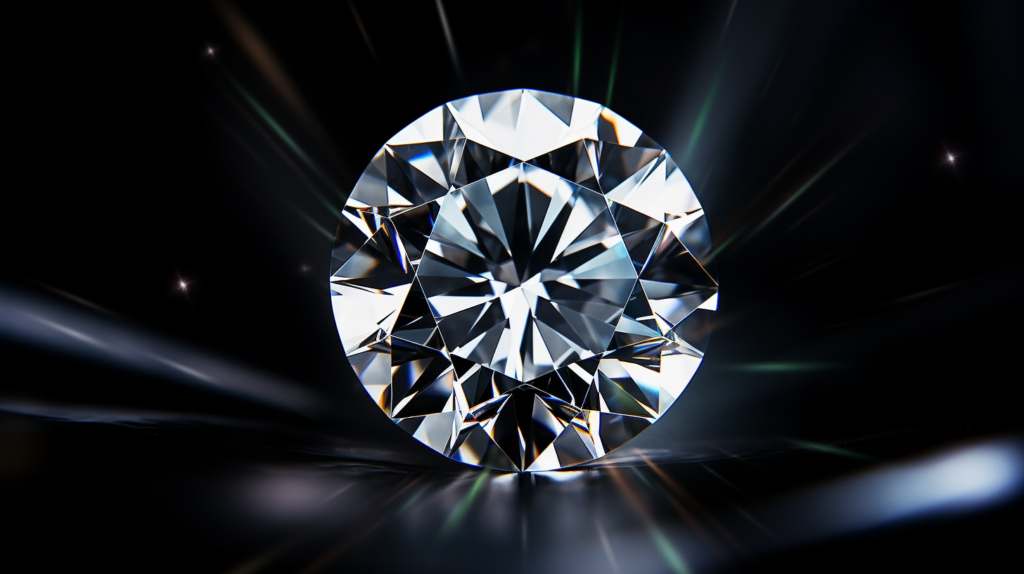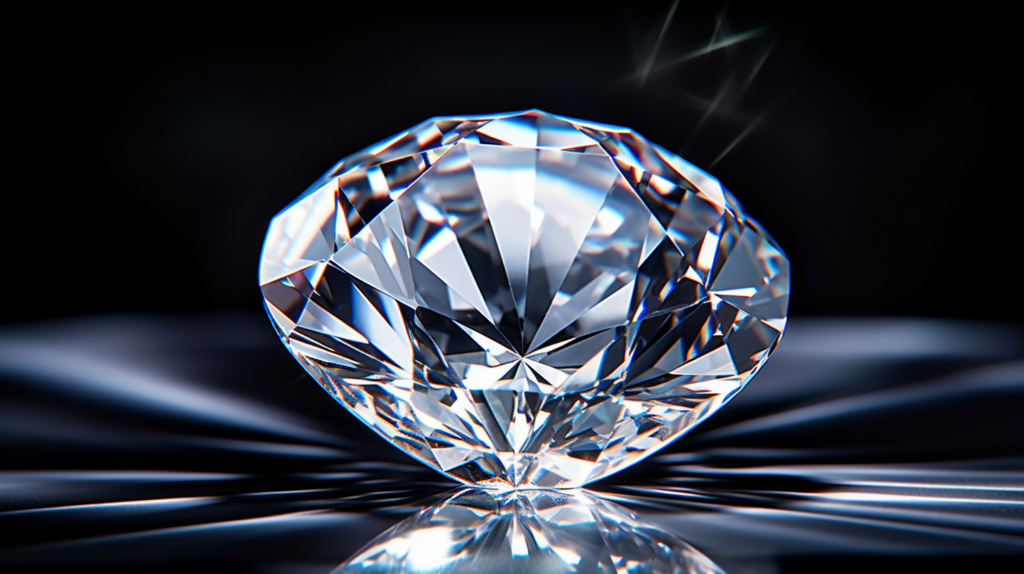Explore diamond cuts, from its historical origins emphasizing weight and symmetry to today’s super-ideal diamonds maximizing brilliance. This Brigthtguide full guide takes you on a journey from the earliest ways to cut a diamond, when keeping the weight and keeping the symmetry of the diamond’s rotation was important, to the present day when super-ideal diamonds are used to get the most light return and shine.
We’ll look at how different cuts, like the classic emerald and step-cut stones and the current brilliant-cut stones, have changed over time. So, whether you’re a beginner or an expert, get ready to learn how the cut affects not only how these valuable stones look but also how much they’re worth.
Key Takeaways
- Diamond cuts have evolved over centuries, from early octahedral forms focusing on weight preservation to today’s super-ideal cuts maximizing brilliance.
- The history of diamond cuts includes shifts from less symmetrical cuts to more symmetrical arrangements, resulting in brighter and more beautiful diamonds.
- Over time, understanding pavilion depth and critical angle of cuts reduced light leakage, leading to diamonds with better internal reflection and standardized grading.
- Today’s super ideal diamonds represent the pinnacle of cutting, emphasizing perfect ratios, symmetry, and facet arrangements for maximum brilliance.
- When selecting a diamond cut, consider budget, personal preferences, table size, pavilion depth, and the impact on brilliance and value, while understanding the Four Cs (cut, carat, color, and clarity).

In this post, we’ll explore:
- Diamond as Rough Stones
- Super Ideal Diamonds
- Diamonds Cuts in the Present Day
-
How to Pick the Best Diamond Cut
- Your Budget and Choices
- Table Size and Light Leaks
- Pavilion Width and Table Shape
- Angle and Faceted Girdles for Pavilions
- Picking the Right Diamond Cut
- Diamond Carat Weight and Grading Standards for Diamond Cut
- Colored Diamonds and Colors in the Spectral Spectrum
- Shape and Outlines That Aren’t Even
- How diamonds are cut and their history
- Grades and Quality
- Accent Stones and Stones cut
- Maintenance of Weight and Table Ratio
- Why it’s important to have a professional cut your diamond?
- Effect of Cuts on the Price of Diamond
- Popular Diamond Shapes and Cuts
- Tips for a Successful Diamond Cutting
- Conclusion
Diamond as Rough Stones
The earliest form starts in the 10th century and goes right up to the present day. In the 10th century, diamond polishers predominantly worked with the octahedral crystal form, emphasizing weight preservation and showcasing the diamonds’ natural beauty through rotational symmetry, 10-fold symmetry, and 12-fold symmetry.
This was a time when the table size and table facets were not as meticulously crafted as they are today, but the focus was more on the diamond’s natural characteristics. Shapes changed by the middle of the 16th century, laying the groundwork for the beautiful cut stones we see today. These cuts made the facet arrangements more symmetrical, which made the diamond shine brighter.
The diamond-cutting process evolved to include a wide range of shapes, from the classic emerald cut to the romantic teardrop shape. By the time we reached the era of rose-cut diamonds and mogul-cut diamonds, light leakage had become a critical factor to consider. Advances in understanding pavilion depth and the critical angle of cuts led to diamonds with better internal reflection, reducing light leakage significantly.
Don’t miss this: Exploring the Diamond Culet

Super Ideal Diamonds
In today’s world, the super ideal diamond represents the pinnacle of diamond cutting, with its perfect table ratio and steep pavilion angle designed for maximum brilliance. The symmetry, table sizes, and facet arrangements of these diamonds are all perfect because they were carefully made with cutting-edge technology.
These fancy cut diamonds reduce light leakage and increase light return to create a larger stones possible. The process of diamond cutting now even accommodates girdle irregularity and upper girdle facets, allowing for a noticeable difference in the diamond’s overall appearance and value.
Don’t miss this: Understanding Diamond Depth and Table
Diamonds Cuts in the Present Day
Brilliant cut stones have evolved into a highly specialized art form in the modern era. Experts all over the world, including African diamond cutters, use cutting-edge technology, critical angles, and girdle irregularities when they cut and grind diamonds. Each cut is made to keep the weight of bigger stones while getting the best quality possible.
From the rose-cut diamonds of the 10th century to the mogul-cut and lasque diamonds of the 18th century, the history of diamond cuts shows how creative and resourceful people can be. It shows how fascinated we are with the way the colors play with each other inside these precious gems.

How to Pick the Best Diamond Cut
When picking a diamond, you should think about what you like and how much you can spend. To get the most light return, the right table size is also very important. Here’s a comprehensive guide to help you make an informed decision:
Your Budget and Choices
Your budget and personal preferences can have an impact on the type of diamond cut you select. Prices may change for different cuts, so it’s important to choose the one that fits your style and your budget.
Table Size and Light Leaks
The right table size can have a big effect on how bright a diamond is. To make sure your diamond sparkles beautifully, you need to find the right mix between letting the most light back in and letting as little light out.
Pavilion Width and Table Shape
The pavilion depth and the quality of the table facets are very important for internal reflection, which makes the diamond sparkle and fire even more. To choose a diamond with amazing brightness, you need to know about these things.
Angle and Faceted Girdles for Pavilions
For light to enter the diamond at the best angles, the pavilion angle must be steep and the girdles must be well-faceted. It makes a lively stone with bright fire and scintillation, which makes it a fascinating choice.
Picking the Right Diamond Cut
Whether you like the classic emerald cut or the more modern Super Ideal Diamond, the cut of the diamond has a big effect on how it looks overall. Look at the different cuts to find the one that fits your style and tastes the best.
Diamond Carat Weight and Grading Standards for Diamond Cut
You need to know about the Four Cs (cut, size, color, and clarity) and the grading standards that determine diamond quality in order to make an informed choice. These things together decide what makes a diamond valuable and unique.
Colored Diamonds and Colors in the Spectral Spectrum
Colored diamonds are a beautiful choice for people who want something different. Because they reflect light inside, these gems have a lot of different colors, giving them a unique and colorful look.
Shape and Outlines That Aren’t Even
Diamonds can be cut into many different shapes, from the standard round cut to the more unusual pear shape and octagonal outline. The form you choose for your diamond can have a big effect on how beautiful it looks.
How diamonds are cut and their history
Knowing how diamond cuts have changed over time, from their earliest forms to the current modified cuts, helps you appreciate the skill that went into making these valuable stones. Learning more about how diamonds are cut and their long past can help you understand and appreciate them more.
Grades and Quality
It is very important to choose a diamond that meets high-quality grade standards. These standards make sure that the finished stone you get is of the highest quality, shining and beautiful.
Accent Stones and Stones cut
You might want to add a little extra flair to your jewelry by looking into accent stones or specific cuts like step-cut stones. These features can make your diamond jewelry look better and more stylish overall.
Maintenance of Weight and Table Ratio
The table ratio and how well the diamond keeps its weight have a clear effect on its size and how it responds to light. By giving these things careful thought, you can choose a diamond that shines brightly and fits your needs.
By keeping these factors in mind, you’ll be well-equipped to choose a diamond cut that not only meets your aesthetic preferences but also offers the best value for your investment.
An interesting read: Diamond Vs Moisannite: A Battle of Two Stunning Gemstone
Why it’s important to have a professional cut your diamond?
Arrangements of the facet diamonds and perfect symmetry are two of the most important parts of making a beautiful diamond. Getting the pavilion angles, upper girdle facets and girdle irregularity just right are all important parts of making diamonds that sparkle incredibly.
Excellent cut diamonds meet the highest standards for diamond cut, which makes them shine and sparkle like nothing else. If you cut a diamond too shallowly or too deeply, it can lose its shine. The right proportions let light into the diamond and reflect it back out, giving it the most fire and sparkle.
When judging the proportions of a diamond, these four things are very important:
- Table Facet: The table facet is the big, flat part on top of the diamond. Its size affects how light comes in and goes out of the diamond.
- Pavilion Depth: The pavilion depth is the distance between the bottom of the girdle and the culet of a diamond.
- Step-Cut Stone: For step-cut stones like emeralds and Asscher cuts, proportions are very important. For these cuts to have the best hall of mirrors effect, the exact arrangement and proportions of their step-like facets are very important.
- Table Ratio: This ratio changes how the diamond looks when it is held up to the light and can affect how well it is cut overall.
Effect of Cuts on the Price of Diamond
Getting the perfect diamond cut has a big effect on the price of a diamond because it determine how beautiful and bright it is. This list shows four main things that show how diamond cut affects price:
- Diamond Cut: The grade of the cut has a direct effect on the beauty and value of a diamond. A well-cut diamond reflects light as much as possible, which makes it sparkle and look more appealing.
- Carat weight: Diamonds with a higher carat weight typically cost more. A well-cut diamond with a lower-carat weight can still be beautiful to look at and worth a lot of money.
- Popular Diamond Shapes: The round brilliant and princess cut diamond shapes are two of the most popular and sought-after diamond shapes. The price of these diamond cuts may change because they are so popular.

Popular Diamond Shapes and Cuts
You can choose from a number of different diamond cuts and shapes.
Brilliant Cut Diamonds with a Round Shape
These are rough diamonds that have been studied a lot in diamond cut studies and are very valuable in diamond grading. The arrangement of the facets in a round brilliant cut diamond makes it sparkle and fire the most. The 58 facets are placed in a way that makes them interact with light in a way that makes a stunning show of sparkle.
A round brilliant diamond has been the subject of many studies to find out what its best proportions and symmetry are.
Princess Cut Diamond
People who want to look modern and edgy often choose princess-cut diamonds. This diamond cut gives classic designs a new look with its square shape and sharp corners. Jewelry designers have numerous options when setting the princess cut, as it can be placed in either a square or compass point shape. They often use box claws to highlight its 90-degree angles, enhancing its angular appeal.
Marked Diamond in Emerald
We love how classic and classy an emerald-cut diamond looks. For those who want sophistication and understated beauty, this is a classic choice. A diamond with long, straight cuts that look like steps is called an emerald-cut diamond. This cut makes a hall of mirrors effect that shows off the diamond’s clarity and transparency.
Diamond Cut in a Cushion
As the second most popular diamond shape, the cushion-cut diamonds are becoming more and more popular due to its exceptional brilliance. It comes in a soft square or rectangular shape that looks like a cushion. It’s often a client favorite because of its unique look.
Round Cut Diamond
The radiant cut diamond has a unique pattern of facets and cropped corners that give it a brilliant and striking shine. When you cut a diamond with a brilliant cut facet pattern, it makes it sparkle like crazy. Cropped corners give diamonds a unique appearance.
Cut Asscher
Step-cut diamonds like asscher cut diamond is a favorite among diamond enthusiasts in the diamond industry because of its unique square shape and incredible brilliance. The light show from its famous features—a high crown, a deep pavilion, and a large step-cut facet—is mesmerizing.
People love the Asscher cut diamond because it is clear and has a natural beauty. Jewelers and engagement ring enthusiasts continue to embrace the asscher cut diamond due to its vintage charm and enduring elegance.
Diamond in the Shape of a Pear
Pear-shaped diamonds are known for how bright and shiny it is. There is a beautiful show of fire and scintillation because of its 58 facets that reflect light so well. These diamonds are a popular choice for people who want something classy and unique.
Because of its unique shape and classic look, it’s a great choice for diamond engagement rings. They also come in round and teardrop shapes, and their ends are pointy. This pear-cut diamond makes the finger look longer and more elegant.
Oval Shaped Diamond
An oval-shaped diamond is among quality diamonds and is a classic choice for an engagement ring because of its long shape and bright shine. In the 1960s, Lazare Kaplan came up with it. Because they are so unique, oval-cut diamonds are very popular in the diamond business. It looks like your fingers are longer and thinner when you wear oval-shaped cuts.
Marquise-Cut Diamond
The marquise cut diamond is a perfect shape and famous diamond and a perfect choice for people who want a long and thin diamond. The symmetrical facet arrangement makes the marquise-cut diamond shine the brightest. The ends of this cut are pointy, and the shape is long, like a boat hull.
Diamond in the Shape of Heart
This heart-shaped diamond is a modified brilliant cut. If you polish a Heart-shaped fancy diamond, it usually has 59 facets. The best ratio for length to width is between 0.9 and 1.2:1.
Tips for a Successful Diamond Cutting
The diamond-cutting procedure carefully transforms a rough stone into a stunning gem. The diamond-cutting process combines science and art. It involves turning a rough, uncut diamond into a jewel with several faces that dazzle brightest. Here are some tips for a successful cutting of diamonds.
Choose Your Diamond Cut
The choice of diamond cut affects the final appearance. Cutters must consider diamond characteristics and choose a cut that highlights them. Mogul-cut diamonds are a unique and lively stone, while round brilliant and princess cuts are popular standard diamond cuts.
Grading Standards
Diamond cut grading standards evaluate diamond cuts. These guidelines examine the pavilion facets, pavilion step-cut, and pavilion terminus. Paying attention to these aspects results in a magnificent diamond with excellent balance and brilliance in the finished stone.
Brightness, Symmetry
Diamond cutting is art because of balance and symmetry. An 8-fold symmetry is desired since even a tiny difference might result in a noticeable difference in size and internal reflection of light. Keeping carat weight while enhancing shine is tough but required.
Magic of Inner Brilliance
One of the miracles of the process of diamond cutting is the creation of interior brilliance. The spectral colors that dance inside the stone become apparent due to internal reflection and light scattering. Diamonds are more gorgeous because of the colored light created by meticulous cutting.
Compare Classic and Unique Outlines
Diamond cutters can form gems normally or uniquely. Asymmetric outlines, like the octagonal outline, give something distinct and current to the classic outline, which is popular since it lasts for a long time.
The process of diamond cutting is complex, and the range of quality in the finished stone might vary. Differences in size, form of step-cut stones, and accent stone choice can all alter the outcome.
Conclusion
To sum up, we’ve looked at the different things that affect the cut quality of a diamond and how important the GIA diamond cut scale is for judging and comparing diamonds. The beauty and value of a diamond depend significantly on how well it is cut and polished, enabling it to both capture and reflect light effectively.
Cutting a diamond is a fascinating procedure that creates a stunning jewel from a rough stone. The method requires skill, accuracy, and diamond understanding. The finished stone is a work of art with unique beauty, brilliance, and symmetry. The talent and workmanship of these precious stone makers are evident.
Sources
BrighterGuide is dedicated to providing accurate and relevant information as you explore the wonderful world of diamonds and jewelry. To this end, our writers refer to primary information sources in building each article that appears on this website. These include, but are not limited to, published news articles, government portals, research papers, and more.
- Learn How to Buy a Diamond with the GIA Diamond Buying Guide | 4Cs of Diamond Quality by GIA. (2022, July 22). GIA 4Cs. https://4cs.gia.edu/en-us/diamond-buying-guide/
- Natural Diamond Grading Reports & Services. (n.d.). https://www.gia.edu/gem-lab-service/diamond-grading
- Laboratory-Grown Diamond Reports & Services. (n.d.). https://www.gia.edu/gem-lab-service/laboratory-grown-diamond